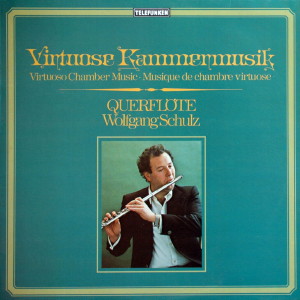 |
1 LP -
Telefunken 6.42364 AP (p) 1979
|
|
| VIRTUOSE KAMMERMUSIK - Querflöte |
|
|
|
|
|
|
|
| André Jolivet
(1905-1974) |
"Suite
en concert" für Flöte und
Schlagzeug - (2. Flötenkonzert
- 1965) - Jean-Pierre Rampal
gewidmet *
|
|
14' 51" |
A1 |
|
- Modéré -
Frémissant |
4' 30" |
|
|
|
- Stabile |
2' 50" |
|
|
|
-
Hardiment |
2' 53" |
|
|
|
- Calme -
Vèloce - Apaisè |
4' 38" |
|
|
| Luciano Berio (geb. 1925)
|
"Sequenza" I für
Flöte solo (1958) - Severino
Gazzelloni gewidmet |
|
5' 34" |
A2 |
| Olivier Messiaen (geb. 1908)
|
"Le merle noir"
(Die schwarye Amsel) für
Flöte un Klavier (1952) |
|
6' 37" |
B1 |
|
- Modéré -
Un peu vif, avec fantaisie |
|
|
|
| Helmut Eder (geb. 1916) |
"Sonatine"
für
Flöte und Klavier,
Op. 34 Nr. 4 (1969) - für
Wolfgang Schulz |
|
7' 11" |
B2 |
|
- Moderato
a piacere
|
1' 26" |
|
|
|
- Adagio
piano
|
2' 53" |
|
|
|
- Vivace
leggiero |
2' 52" |
|
|
| Frank Martin (1890-1974) |
"Ballade" für
Flöte und Klavier (1939) |
|
7' 11" |
B3 |
|
- Allegro
ben moderato |
|
|
|
|
|
|
|
|
| Wolfgang SCHULZ,
Querflöte |
- Kurt Prihode,
Schlagzeug *
|
|
| Helmut DEUTSCH,
Klavier (STEINWAY-Flügel) |
- Roland Altmann,
Schlagzeug *
|
|
|
- Gerald Fromme,
Schlagzeug *
|
|
|
- Rudolf
Schmidinger, Schlagzeug
*
|
|
|
|
|
|
Luogo
e data di registrazione |
|
-
|
|
|
Registrazione:
live / studio |
|
studio |
|
|
Recording
Supervision
|
|
-
|
|
|
Edizione LP |
|
TELEFUNKEN
- 6.42364 AP - (1 LP - durata 41'
22") - (p) 1979 - Analogico |
|
|
Originale LP
|
|
- |
|
|
Prima Edizione CD |
|
-
|
|
|
Note |
|
-
|
|
|
|
|
The
transverse flute
already figured in
the grammophone
record series
"Virtuoso Chamber
Music". On that
occasion it
featured beside
the recorder,
which it
eventually
supplanted as the
more expressive
and tonally more
intense
instrument, with
music of the
baroque eta
(Telefunken
6.42330). The
present record
confirms the
greater
possibilities of
flute playing. The
examples selected
here not only
illustrate the
fact that direct
alternating
effects exist
between
composition and
virtuosity, but
also that as a
consequance of
this, extremely
difficult
techynical
achievements such
as have never been
experienced
before, can be
demanded of
interpreters of
new music. It is
not a coincidence
that the works of
French composers
predominate here.
This is already
explained by the
marked preferences
which are known to
have existed in
France for winds
and wind music.
(even today, wind
players from
France make up the
bulk of the Boston
Symphony
Orchestra).
André Jolivet
(1905-1974) was
admittedly not
regarded as an
untimely composer,
but certainly as
an "outsider". In
1936, tohether
with Messiaen,
Lesure and
Baudrier, he
founded the group
of composers known
as "Jeune France".
Its aims were to
seek an
independent French
tonal language,
influenced by
neither the maxims
of the "Viennese
school" nor the
"rules of the
game" of
neoclassicism. The
Suite en Concert
factually the
second flute
concerto) composed
in 1965 accords
with these
concepts. The
four-movement work
covers in the wind
part - in which
the deeper tone
values are
effected by using
a second
instrument in the
second movement -
the range of the
flute's intrinsic
representation
means. The flute
and the percussion
arsenal, for which
four players are
required, are
structurally
integrated,
althought tonally
divided. With his
rhapsodically
generous treatment
of the wind part,
to which the
percussion section
is apportioned as
a differentiating
correlate, Jolivet
turns down the
emotionless
construction
models, thus
sparing the
executant (and
listener) the path
into isolating
esoteric regions.
The Sequenza for
Flute alone,
written in 1958 by
Luciano Berio
(born 1925) is
unorthidox from a
compositional
point of view,
although more
progressive. Berio
applies the
principle of group
permutation here,
and for the rest
also tries to
solve the time
problem in music
in a graphical
manner. Tonally
the part is marked
by spontaneity and
impulsiveness,
which leaves every
possibility of
virtuoso sound
development open
to the
interpreter. The
melodic structures
of the duet piece
"Le merle noir",
composed in 1952
by Olivier
Messiaen (born
1908), were copied
from the
blackbird. In this
latter piece the
cadence, canon and
independent quaver
movement are
linked up with
each other. Helmut
Eder (born 1916)
called his
composition for
flute and piano
Sonatine, Frank
Martin (1890-1974)
on the other hand
Ballade. While
Eder was guided by
a stricter formal
concept, Martin
was inclined to
choose the freer,
epic tonal form.
With this
obligatory piece
for the first
Geneva Music
Competition in
1939, which he and
Ernest Ansermet
later arranged for
string and
orchestral
accompaniment,
Martin made
skilful use of
probably every
kind of
performance
experience and
colour value of
modern flute
playing,
particularly in
the vivace
section, in both a
pleasing and
effective manner.
Gerhard
Wienke
(English
translation by
Frederick A.
Bishop)
|
|
|

